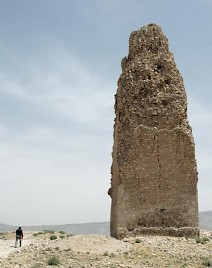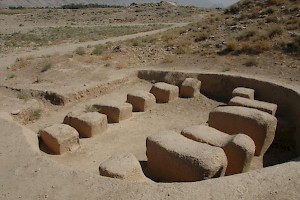Ardašir Khureh (Firuzabad)
https://www.wikidata.org/wiki/Q720952Ardašir Khureh ("fame of Ardašir): Sasanian city in Persis, modern Firuzabad. Except for the city (discussed on this page), there is a castle, a palace, a large relief celebrating Ardašir's victories, and a small relief commemorating his investiture.

Like many cities from the Parthian age, Ardašir Khureh ("fame of Ardašir) was designed like a large wheel and was surrounded by large walls. In the center of this wheel was a tall tower, which is locally known as the minar (minaret). It is more than thirty meters tall and its function is not known. Here, the four main streets of the city came together.
The city appears to have been founded near an older castle after a local ruler named Ardašir had united southern Iran in the first quarter of the third century CE. His Parthian overlord, king Artabanus IV, was alarmed and in 224 decided to repress the insurrection, but he was defeated.

This is commemorated by the first relief, just north of the circular city, along the road to Istakhr. Two years later, the Parthian capital Ctesiphon was captured and Ardašir was recognized as ruler of the former Parthian Empire; this is the subject of the second relief.
The wall that surrounded the circular city is about 450 meters from the center; there is a less impressive outer wall, which is much wider. The places of the gates in the inner wall can still be recognized.
Hardly any buildings have been excavated, partly because they were made of limestone and similar, perishable material; partly because the city was also used by nomads; partly because the site has not received as much attention as, for example, the Sasanian city of Bishapur. The site is therefore hard to recognize as an archaeologically important location; there are not even sherds. Most visitors prefer the palace, which is a bit to the northwest, across the river.

Still, there are several interesting sights to be seen. A platform of large, square stones is all that remains of an ancient monumental building. It is not far from the minar, but no one knows to what kind of structure they belonged to; it may or may not have been a sanctuary for fire worship. Recently, an ancient bathhouse was identified.
When I visited the site for the second time in 2008, another monumental structure had been discovered, but the archaeologists were not yet able to tell what it might have been.







